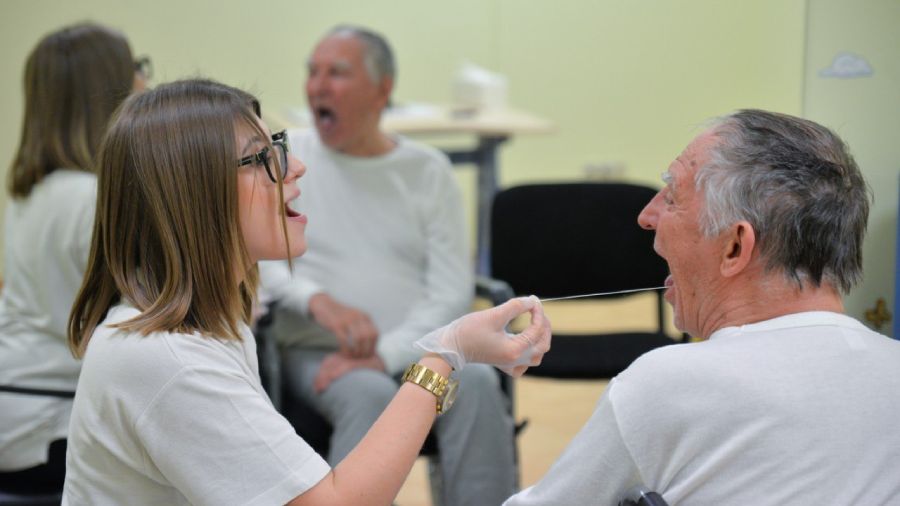Difficulties are common but can be managed
Medically reviewed by Diana Apetauerova, MD
If you have Parkinson’s disease (PD), you probably notice that people ask you to repeat what you just said more than they used to. In addition, speaking clearly and intelligibly becomes a little more difficult when you have PD.
While the majority of people with PD experience some type of speech problems, few get treatment for those speech problems. This is unfortunate as research shows that effective treatments are available for speech, voice, and language problems in PD.
Speech Problems of Parkinson’s Disease
The most common speech problems experienced by people with PD involve reduced volume (hypophonia), reduced pitch range (monotone), and difficulty with the articulation of sounds or syllables (DYSARTHRIA). In essence, you can’t speak as loudly as others, you find it more difficult to convey emotion when you do speak, and you find it difficult to form the words you are trying to pronounce.

You don’t need me to tell you that this combination of factors makes speaking extremely frustrating. When you couple all of these voicing problems with the so-called ‘masked faces’ of PD, the difficulty in expressing emotions via facial expression, it’s no wonder that people occasionally find it challenging to understand what you are trying to say.
It may be tempting to withdraw from conversations with others altogether, but that would be a mistake. You need to interact with others on a daily basis, no matter how frustrating it becomes — this is critical for your mental health, and be assured that your loved ones want to interact with you. The good news is that there are treatments, such as voice exercises, that can dramatically improve the voicing problems associated with PD.
APHASIA. DYSARTHRIA. SET №1:TONGUE EXERCISES
For additional information about the rehabilitation of the patients with Aphasia, Dysarthria you can watch a video demonstrating exercises and rehabilitation recommendations.
Language Problems of Parkinson’s Disease
Besides the frustrating speech and voicing problems of PD, there may also be language problems. These language problems very likely make the speech problems more difficult to deal with, so it is important to identify these language difficulties when they appear.
Speech is about expressing ideas via the use of language. Language is a cognitive ability that can be present even when you cannot speak. In the case of people with PD, they may exhibit word-finding difficulties and grammatical difficulties. They tend, for example, to use simplified sentence structures with an increase in the ratio of open-class items (nouns, verbs, adjectives) to closed-class items (determiners, auxiliaries, prepositions, etc.), as well as an increase in the frequency and duration of hesitations and pauses.
When listening to others speak, it’s sometimes hard for persons with PD to understand the other’s language, if they use complicated sentences to express their ideas. Thus, in both the production of language and comprehension of language, people with PD sometimes experience significant difficulties.
APHASIA. DYSARTHRIA. SET №2:LIP EXERCISES
Treating Speech and Language Problems in Parkinson’s Disease
Potential treatments for speech and language problems of PD include medication, behavioral therapies, and surgery. The most recent assessments of these therapies suggest, however, that surgery (particularly deep brain stimulation) is not effective for speech problems, although it may improve some of the severe motor problems of PD. In addition, there are no medication therapies that are effective when used alone.
Treating the basic motor problems of PD optimally (with medication) appears to be a prerequisite for improving speech problems. That is, if the PD motor problems are untreated, the speech problems do not respond well to behavioral treatments. PD medication is, therefore, necessary but not sufficient. In short, the optimal treatment strategy for speech and language problems of PD appears to be a combination of PD medication (like levodopa) plus some form of behavioral speech therapy.
APHASIA. DYSARTHRIA. SET №3: CHEEK EXERCISES
Behavioral Speech Therapy for Parkinson’s Disease
Behavioral speech therapy usually involves a series of voice exercises administered by a trained and certified speech therapist. These exercises include training in control of speech rate, stress/intonation, or expression of emotion, loudness, articulation, and breathing, so as to support the voice. Sometimes the therapist uses assistive instruments, such as delayed auditory feedback, voice amplification devices, or pacing boards.
Some investigators have claimed significant success with PD patients by using the so-called Lee Silverman Voice Treatment (LSVT), an intensive program of voice exercises that targets vocal intensity, quality, and variation — precisely the areas of difficulty for persons with PD.
The LSVT approach centers on a single therapeutic target at a time so that effort can be invested in achieving that target alone. A therapeutic target might be increasing vocal loudness or enhancing speech intelligibility. In pursuing these sorts of therapeutic targets, the patient is drilled on a series of voice exercises and is taught to be aware of sensory feedback from the voice, as well as to self-monitor voicing patterns and voice quality. The increased self-awareness of voice allows for the correction of errors and for faster progress toward the target.
APHASIA. DYSARTHRIA. SET №4: JAW AND PALATE EXERCISES
Bottom Line
The available evidence suggests that these sorts of behavioral speech therapy regimens really work, so there is no reason for you to keep having frustrating conversations with others
APHASIA. DYSARTHRIA. SET №5: RESPIRATORY-VERBAL, ARTICULATORY EXERCISES
By Patrick McNamara, PhD
Patrick McNamara, PhD, is an associate professor of neurology and the director of the Evolutionary Neurobehavior Laboratory.who pretend they understand what you are saying. Instead, you will re-learn to clearly and loudly speak your mind.

DEMO VERSION OF GHRS EXERCISES FOR THE PATIENS WITH APHASIA, DYSARTHRIS ON YOUTUBE.
Our website presents the following sets of exercises for rehabilitation of the patients with Aphasia, Dysarthria:
-
APHASIA. DYSARTHRIA. SET №1:TONGUE EXERCISES
-
APHASIA. DYSARTHRIA. SET №2:LIP EXERCISES
-
APHASIA. DYSARTHRIA. SET №3: CHEEK EXERCISES
-
APHASIA. DYSARTHRIA. SET №4: JAW AND PALATE EXERCISES
-
APHASIA. DYSARTHRIA. SET №5: RESPIRATORY-VERBAL, ARTICULATORY EXERCISES
Demo version of GHRS sets of exercises for Parkinson’s Disease on YouTube
Our website presents the following sets of exercises for the rehabilitation of the patients with Parkinson’s Disease:
-
SET OF EXERCISES №1 FOR PARKINSON’S DISEASE: IMPROVING JOINT MOBILITY AND INCREASING BODY FLEXIBILITY
-
SET OF EXERCISES №2 FOR PARKINSON’S DISEASE: STRENGTHENING OF THE MUSCULOSKELETAL AND MUSCULAR SYSTEM, ENDURANCE
-
A SET OF EXERCISES №3 FOR PARKINSON’S DISEASE: IMPROVING THE COORDINATION AND “COMPOSITION” OF MOVEMENT – DIVIDING IT INTO COMPONENTS
-
A SET OF EXERCISES №3 FOR PARKINSON’S DISEASE: IMPROVING THE COORDINATION AND “COMPOSITION” OF MOVEMENT – DIVIDING IT INTO COMPONENTS
Tips for Coping
It can be very frustrating to want to communicate, but not be understood. If your speech has been affected by MS, these strategies can help your interactions with others.
Inform Others of Your Challenges
If you’ve ever heard a recording of yourself speaking, you know how different your voice can sound on tape from what you hear in your head. It’s the same thing when you talk to other people—they may find your speech to be much clearer than you think it is.
If you are concerned about how you sound, don’t hesitate to give your listener a heads-up and tell them you sometimes struggle to express yourself clearly.
Take a Break
In the heat of a moment of frustration, communicating clearly can be difficult for anyone. You may find it particularly challenging.
Take a few minutes to regroup. Breathe in deeply until you feel ready to go back to your conversation. When you do, keep your sentences short and speak slowly.
Communicate in a New Way
Very rarely, dysarthria caused by MS can leave a person unable to be understood—or even speak—at all. In that case, there are various workarounds to try, including alphabet boards, note pads, hand gestures, sign language, and electronic or computer-based aids.
Summary
Scanning speech and other symptoms of dysarthria don’t create physical pain, but they can lead to anxiety, frustration, and a lack of self-confidence. Don’t hesitate to seek help.
Living with dysarthria can be frustrating because these speech disorder make it difficult to communicate. Dysarthria can partially or completely improve on its own, depending on the cause. If your dysarthria is not expected to improve on its own, therapy and exercises will help optimize your ability to speak and communicate clearly.
FREQUENTLY ASKED QUESTIONS
1. What type of dysarthria is most common?
Mixed dysarthria is the most common type. It’s caused by damage to several regions of the nervous system, but particularly the upper or lower motor neurons.4
2. Is dysarthria the same as dysphagia?
Dysphagia is trouble swallowing. A lot of conditions that lead to dysarthria can also cause dysphagia. For example, people who have had a stroke or a person with multiple sclerosis (MS) may develop dysphagia, dysarthria, or both.5
3. How do Parkinson’s disease symptoms differ between men and women?
Men are more likely to have Parkinson’s related cognitive problems than women and more severe problems with freezing gait, drooling, and bent spine.4 Women are more likely to suffer from fatigue, depression, restless legs, pain, and tremors, and they have a higher risk of falling.
4. Is loss of a sense of smell a sign of Parkinson’s disease?
Yes. Loss of smell is common with Parkinson’s disease, but other conditions can cause it, too. Your sense of smell gradually lessens over time, so you may not realize it’s diminished until you’ve already developed other symptoms.
5. Do all people with Parkinson’s disease shake uncontrollably?
About 80% of people with the disease experience tremors. Characterized by involuntary quivering movements, these “resting tremors” occur when you’re not moving.
Sources
https://www.verywellhealth.com/parkinsons-disease-related-speech-and-language-problems-2612189
- Mahler, L.A., Ramig, L.O., & Fox, C. Evidence-based treatment of voice and speech disorders in Parkinson disease. Current Opinion in Otolaryngology & Head and Neck Surgery, Jun;23(3):209-15.
- Ramig, L.O., Fox, C., Sapir, S. Speech treatment for Parkinson’s disease. (2008). Expert Review of Neurotherapeutics, Feb;8(2):297-309. Review.
Additional Reading
- American Speech-Language-Hearing Association. Dysarthria.
- National Multiple Sclerosis Society. Speech proble








